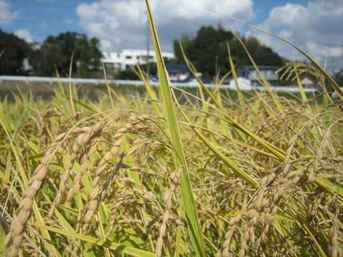 I saw the golden color(KOGANEIRO) rice field(TAMBO) on the way of the library(TOSHOKAN)
I saw the golden color(KOGANEIRO) rice field(TAMBO) on the way of the library(TOSHOKAN)![]() .
.
I save the photo(SHASHIN NI OSAME MASHITA) ![]() because it is so beautiful
because it is so beautiful![]() .
.
Rice field(TAMBO)is for making rice plant(INE),
Rice field change the color to Gold at many place in the beginning of October,
and we are waiting for the harvest(SHUUKAKU) season.
It is shone on in light where autumn is clear.
When i saw the scenery(HUUKEI)![]() ,I stopped and gazes quietly
,I stopped and gazes quietly![]() for a while(SHIBARAKU NO AIDA)
for a while(SHIBARAKU NO AIDA)
since childwood. ![]() The scenery of rice field that seems that it shines.
The scenery of rice field that seems that it shines.
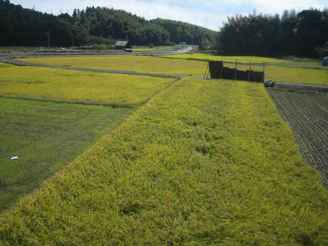 The brown area on the right of the photo has been cut the rice plant(INE WO KARIMASU).
The brown area on the right of the photo has been cut the rice plant(INE WO KARIMASU).
The green area on the left of the photo is not rice field on this year![]() ,
,
may be it is the rest for the rice field![]() .
.
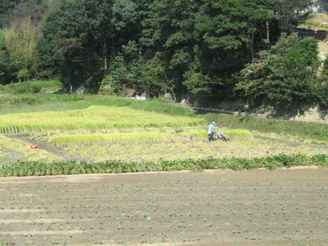 The uncle was harvesting rice in the rice field on the other side of the road
The uncle was harvesting rice in the rice field on the other side of the road![]() .
.
Though the rice plant is cut taking a big tractor in a vast rice field,
In case of rice farm on a small scale
It often cuts it with a small machine as shown in the photograph![]()
![]() .
.
OK!![]() Shall we go down close to him for you?(CHIKAKU MADE ORIMASHOU)
Shall we go down close to him for you?(CHIKAKU MADE ORIMASHOU)![]() I wonder if taking the photo to understand easily.
I wonder if taking the photo to understand easily.
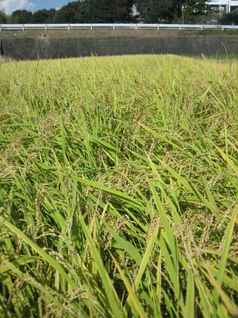 I go down under the road now.
I go down under the road now.
This shot is zoom up.
Japan has HAIKU![]() (It is a Japanese fixed form of verse that consists of the syllable of 5・7・5, and the shortest poetry in the world. ) is "The ear of rice grows if I grow and lowers the tip
(It is a Japanese fixed form of verse that consists of the syllable of 5・7・5, and the shortest poetry in the world. ) is "The ear of rice grows if I grow and lowers the tip
with heaviness and lowers the head"(MINORUHODO KOUBE WO TARERU INAHO KANA![]() )
)
It means that the tip lower an ear of rice which grew,
A human being comes to have high character,
Do it for a partner humbly.
So I remind this sentence when i met like a above.
This is drying time after cutting the rice plant.
They are piled on the mesh table is united the bamboo(TAKE).
To be honesty(JITSU WA),I grow up not in the country(INAKA)![]()
![]() .
.
So I have never seen so zoom this one before.
I introduce it for you,but I also discovered(HAKKEN SHIMASHITA)![]() .
.
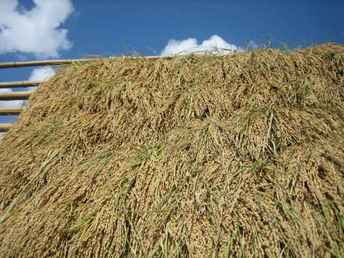 After that,I pass through work called threshing(DAKKOKU) and the rice cleaning(SEIMAI)
After that,I pass through work called threshing(DAKKOKU) and the rice cleaning(SEIMAI)
and appear in the market![]() .
.
Cutting rice plant is starting before 1month at warm areas,
New rice(SHIMMAI)![]() is harvesting on this year already appears in the super market.
is harvesting on this year already appears in the super market.
And,There is the rice is kind of KOSHIHIKARI is made in TOCHIGIis located in the area of KANTOU(north tokyo)![]() .
.
I buy the rice is not included pesticide if possible.
We eat the rice everyday![]() .
.
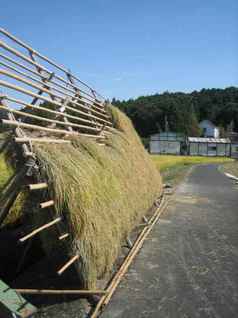
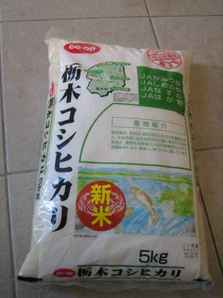


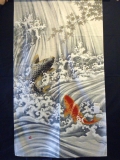
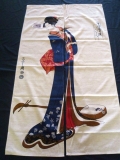
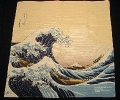
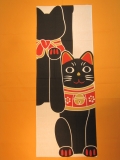


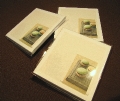


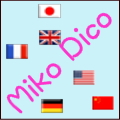
When I was a child I often visited my grandparents in the country. Belarusian farmers often wore out hay on such constructions.